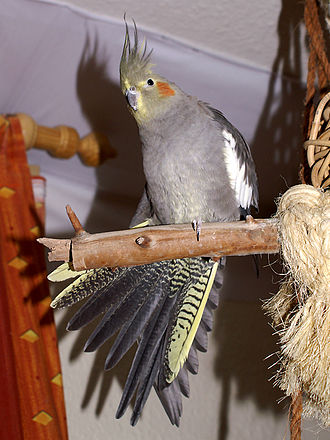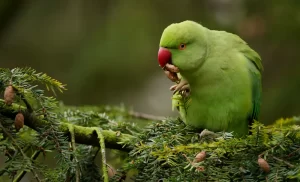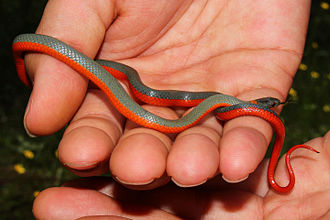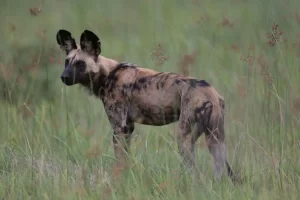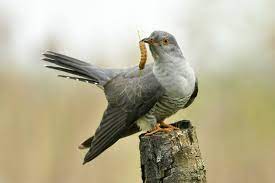In the United States cockatiels are often referred to simply as “tiels”, and in Australia, their native country, as “quarrions” or “weiros”. These birds are the smallest members of the cockatoo family (Cacatuidae). The cockatiel is the single species in its genus. In Australia, it is amongst the most widespread cockatoos.

cockatiels
Although in captivity many color varieties are bred, wild cockatiels have a distinctive appearance, their plumage largely gray, with a yellow face, orange patches on the cheeks, a long, wispy, gray, and yellow crest, and prominent white patches on gray wings. Females and juveniles have duller plumage than adult males. The male’s tail is dark gray, but females and juveniles have yellowish outermost tail feathers with gray barring.
Distribution
Cockatiels are endemic to the mainland of Australia and are widely distributed throughout the country, with more in the southwest. There are not many in Tasmania.

Range of cockatiels
These birds occur in a range of open habitats, generally preferring those that are sparsely wooded and near to fresh water. This small cockatoo lives in open woodland, farmland, savanna, acacia scrub, orchards, and in urban gardens and parks. Learn more about Cockatiel’s with Pritish Kumar Halder.
Description
cockatoo, (family Cacatuidae), any of the 21 species of crested parrots (order Psittaciformes) found in Australia as well as in New Guinea and the Solomon Islands. Most are white with touches of red or yellow; some are black. All have a massive scimitar-like beak for cracking nuts, digging up roots, or prying grubs from wood; feeding is aided by a strong tongue. Cockatoos are treetop, hole-nesting birds; at times they form large, noisy flocks. Because they are showy, inventive, and affectionate, many are caged as pets. Some live more than 50 years.
Especially popular as a pet is the 50-cm- (20-inch-) long sulfur-crested cockatoo (Cacatua galerita), with its handsome crest of narrow, golden, forward-curving feathers. This and other Cacatua species—found in northern and eastern Australia, New Guinea, and Tasmania—are mainly white. Highly social birds, sulfur-crested cockatoos forage in flocks numbering from dozens to 100 and congregate at night in regular roosts, often in trees near water. While the flock is feeding, a few individuals stand sentry in trees nearby to alert others to danger with raucous calls. The cockatiel (Nymphicus hollandicus) is another cockatoo that is a popular cage bird. It is a common bird that lives throughout much of Australia.

cockatiel – female

cockatiel – male
The most widespread and numerous cockatoo species is the 35-cm (14-inch) galah (Eolophus roseicapillus). It is pink with gray wings and sweeps through Australian skies in noisy, gregarious flocks. Galahs, also known as roseate cockatoos, pair for life and defend nest hollows together against intruders. They also cooperate to incubate and feed their two–six young. Newly fledged galahs gather into treetop nurseries of up to 100 birds, awaiting the return of their parents with food—grass, shoots, fruit, and insects.
Habits and Lifestyle
Cockatiels can occur in pairs or in small groups, but they usually congregate in flocks of as many as several hundred birds, especially where food is abundant. An individual within these large groups maintains its own space, perched birds not being in contact with each other. They usually perch on the top of dead trees or on power lines, group members adopting the same position as the others, facing the same direction and into the wind.
These birds are diurnal. At night they sleep in communal roosts in trees, hidden in dense foliage. Before sunrise they leave the roost. These birds are swift, powerful fliers, and flocks will often make long flights to go between foraging grounds, water sources and roosting sites. They are usually silent when feeding on the ground, but noisy in flight. When it is not the breeding season, cockatiels are nomadic and will wander, depending on the seeding of grasses as well as cultivated plants.
Diet and Nutrition
Cockatiels are herbivores (granivores), eating mainly acacia seeds, and also those of both native and cultivated plants, fruits, grains, and berries. They need to drink regularly, and so they are often seen near water.

cockatiels – eating berries
Mating Habits
Cockatiels are monogamous breeders, with pairs forming strong bonds and possibly mating for life. Breeding is from August to December, but occasionally as soon as April, depending on weather conditions, particularly rainfall.
The bird’s nest is a tree hollow, simply lined with wood dust. They can produce several broods each season. Females usually lay between 4 and 7 white eggs. Incubation is for about three weeks by both parents, the female at night, and the male during the day. When they hatch, chicks are covered with thick yellow down.
At around 4-5 weeks old they leave the nest. Young grow quickly and very soon can join nomadic flocks. At about the age of six months, males develop the yellow markings on their faces, but this species is not sexually mature until the age of 13 months for males and 18 months for females.

cockatiels – mating habits
Population
Population threats
The cockatiel is widespread and common and is not currently regarded as being at risk of extinction. Large flocks are, however, regarded by farmers as pests and are sometimes killed under permit.
Population number
According to IUCN, the cockatiel is common and abundant throughout its large range but no overall population estimate is available. Currently, this species is classified as Least Concern (LC) on the IUCN Red List and its numbers today remain stable.

cockatiel – relationship with human
Ecological niche
Although preferring sun-dried seeds, cockatiels can act as seed-dispersers in their habitats when they eat fresh seeds. Being very messy eaters, they scatter seeds and shells up to four or five feet when they eat. They also disperse seeds of the fruit they consume.
Fun Facts for Kids
- Cockatiels were discovered by Europeans in Australia in 1770, becoming popular in the 1900s during the Australian gold rush.
- Cockatiels enter their nest hollow tail first, their tail being so long that they cannot turn around in the nest.
- Cockatiels do not make a screeching sound like many other parrots and can learn to ‘speak’.
- Cockatiels can mimic a range of sounds, including other birds’ calls.
- A galatiel is a chick produced by a cockatiel and a galah mating with each other.
- Males are better than females at whistling and talking. Wild male cockatiels use these sounds to attract females.
Reference

